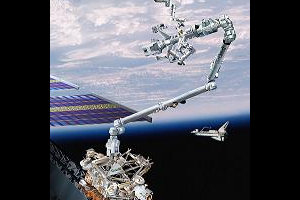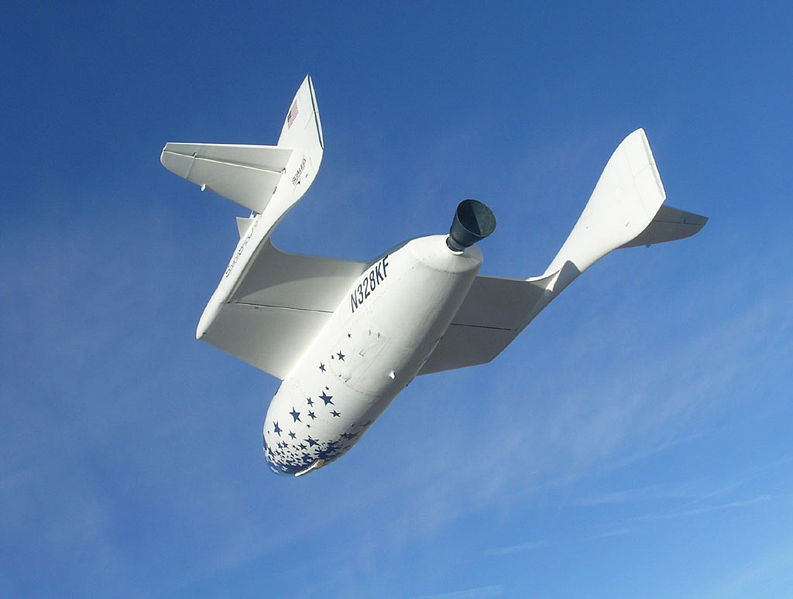Wake Up, It's the Future!
 | | Robots in space--it doesn't get any cooler! |
Tonight—or rather very early tomorrow morning—the space shuttle Endeavour is set to begin the largest and longest space shuttle mission in the history of NASA. Not only are astronauts going up there to do the normal routine of on-orbit experiments and astronaut exchange from the International Space Station, but they are also planning on starting the groundwork for Japan’s first space station as well as erecting a giant Canadian robot affectionately referred to as “Mr. Dextre.”
Last week, NASA’s Cassini spacecraft discovered evidence that one of Saturn’s many moons, Rhea, has its own set of rings. Around the same time, NASA’s Mars Reconnaissance Orbiter found strong evidence that a Martian crater, Holden Crater, once harbored a large and calm lake that would have easily supported life.
Last year, Michael D. Griffin, the current administrator of NASA, announced that one of NASA’s primary aims is to have a man on Mars by 2037. The year before that, NASA made it clear that it has a firm determination to build a fully functional manned lunar outpost by 2024.
 | | Rhea: even moons get jealous |
In two years, the space shuttle will be officially retired, setting the stage for the new Orion spacecraft and Project Constellation. NASA is clearly following the Vision for Space Exploration laid out by President Bush back in 2004, and while an exciting new age of twenty-first century space exploration is being born, nobody’s paying a damn bit of attention.
I don’t mean to sound critical of the public or even the media. In fact, when I set out to write a rant about the current state of space exploration, I was certain I’d be writing about how the days of dreaming about a man on the moon or Mars are long dead, which shows how little I actually knew about what’s going on over at NASA right now. I had read about Rhea and the Martian crater on my Wii News Channel, and I heard a vague blip on the radio last night about a shuttle launch, but I really thought that the Columbia disaster of 2003 (and the resulting NASA budget shake-up) was the final nail in a coffin that had been prepared after the fall of the USSR and the end to the already winding-down space race.
 | | The Orion logo was created by the awesome Star Trek graphic designer Michael Okuda |
I remember when President Bush announced the Vision for Space Exploration, but at the time, people were only interested in Bush’s political motivations for the speech. Very little talk went on in the public eye about the actual mission statement of going back to the moon and then on to Mars, and even that was just cynical criticism. Luckily, it seems that, while the rest of us were rolling our eyes and shaking our heads, NASA was actually taking notes.
A friend of mine whose almost a decade younger recently asked me if we—meaning the average, everyday people of our generation—would be able to go to space before we die. I gave the matter a lot of thought, which might have sewed the seeds for this blog, and I remember saying that I thought it was possible, but unlikely any time soon. I told him about the space elevator, a concept I used to study a few years ago and one that I still believe holds the key to cheap, efficient, and commercially-viable spaceflight, and how nobody seems willing to front the money to actually build it. It is in the private sector—I posited—that our dreams of spaceflight lie.
 | | SpaceShipOne in flight |
That might still be true, though my opinion of the future of space travel has been greatly improved since that conversation. Even NASA is talking about farming out its trips to the International Space Station to commercial enterprises as the shuttle era comes to an end. More importantly, however, is SpaceShipOne, the first privately-funded human spaceship, which launched in June of 2004. In the wake of that landmark event, several companies, including Virgin, Benson Space Company, and Bigelow Aerospace, have begun work on projects designed to put the average Joe in space for a reasonable price. In December of 2004, President Bush signed the Commercial Space Launch Amendments Act into law, which is designed to promote and protect commercial human spaceflight, making it even more likely that we’ll see relatively cheap trips to space, not only in my lifetime, but within the next few years.
It just seems so strange to me that nobody seems all that excited about it.
-e. magill 03/10/2008
|
|